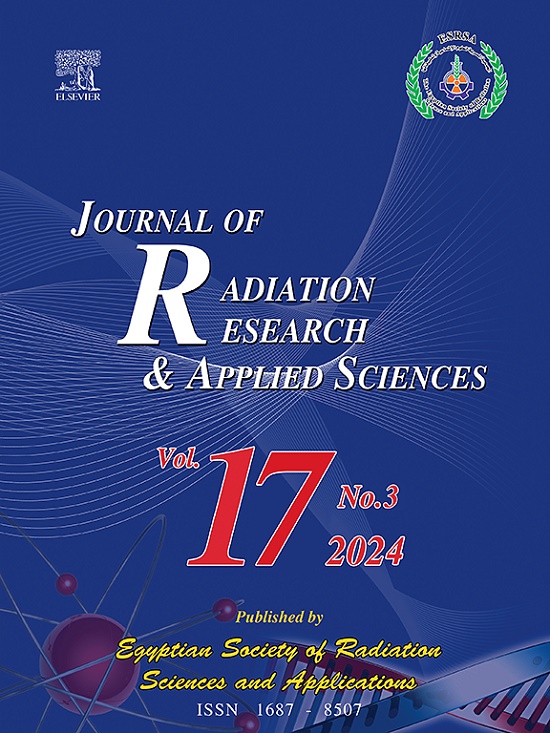Machine learning estimation of heat and mass transfer attributes of thermal radiative Williamson nanofluid flow via nonlinear stretchable surface
IF 1.7
4区 综合性期刊
Q2 MULTIDISCIPLINARY SCIENCES
Journal of Radiation Research and Applied Sciences
Pub Date : 2025-05-12
DOI:10.1016/j.jrras.2025.101581
引用次数: 0
Abstract
Nanomaterials exhibit remarkable thermal properties and have promising utilization in areas such as thermal energy transmission, biopharmaceuticals, the food industry, solar power generation and electric cooling systems. The significant applications of nanoparticles inspired the development of a mathematical model to analyze mass and heat transfer in magnetically influenced Williamson nanoliquid flow across an exponentially extendable surface by incorporating physical factors of Brownian motion and thermophoresis effects along with Arrhenius activation energy and convective boundary constraints. The fundamental equations describing the mathematical structure are designed in the sense of a highly nonlinear coupled partial differential setup. A set of similar variables is utilized to transmute the differential setup into a non-dimensional ordinary system. The attained ODEs are resolved with the implementation of a shooting algorithm in conjunction with the RK-4 technique. Afterwards, a machine learning algorithm based on the backpropagated Leven-berg Marquardt paradigm is also utilized to forecast the numerical outcomes of the quantities of engineering. The impact of relevant flow factors on the associated flow distributions and the quantities of engineering interest are presented via graphical and tabular format. The numerical outcomes signify that momentum distribution dominates by inducing mono nanoparticles as compared to hybrid particles. Enhancement in thermal distribution is perceived by intensifying Brownian motion and thermophoresis effects, whereas contrary aspects are observed for associated flux. In addition, the trained ANN models shows that the best validation performance of Model-A is 1.15e-5 that happens at 565 epochs, while the best validation performance for Model-B is 3.38e-5 at 641 epochs. Small estimations guarantee that model training completed properly. Nusselt number elevates by 29 % for mono and 25 % for hybrid nanoliquid flow when varies from 0.2 to 0.6, while depreciates up to 1.5 % by elevating
非线性可拉伸表面热辐射Williamson纳米流体传热传质特性的机器学习估计
纳米材料具有优异的热性能,在热能传输、生物制药、食品工业、太阳能发电和电力冷却系统等领域具有广阔的应用前景。纳米粒子的重要应用激发了数学模型的发展,通过结合布朗运动和热驱效应的物理因素以及Arrhenius活化能和对流边界约束,来分析磁影响下Williamson纳米液体在指数可扩展表面上的质量和传热。描述数学结构的基本方程是在高度非线性耦合的偏微分设置的意义上设计的。利用一组相似变量将微分系统转化为无量纲普通系统。通过结合RK-4技术实现射击算法求解得到的ode。然后,基于反向传播Leven-berg Marquardt范式的机器学习算法也被用于预测工程量的数值结果。相关流量因素对相关流量分布和工程兴趣量的影响通过图形和表格形式呈现。数值结果表明,与杂化粒子相比,单纳米粒子的动量分布占主导地位。热分布的增强是通过增强布朗运动和热泳效应来感知的,而相关的通量则观察到相反的方面。此外,经过训练的ANN模型表明,模型a在565个epoch时的最佳验证性能为1.15e-5,而模型b在641个epoch时的最佳验证性能为3.38e-5。小的估计保证了模型训练的正确完成。当(Rd)在0.2到0.6之间变化时,单纳米流体的努塞尔数增加29%,混合纳米流体的努塞尔数增加25%,而当(Nt)增加时,努塞尔数最多减少1.5%。
本文章由计算机程序翻译,如有差异,请以英文原文为准。
求助全文
约1分钟内获得全文
求助全文
来源期刊

Journal of Radiation Research and Applied Sciences
MULTIDISCIPLINARY SCIENCES-
自引率
5.90%
发文量
130
审稿时长
16 weeks
期刊介绍:
Journal of Radiation Research and Applied Sciences provides a high quality medium for the publication of substantial, original and scientific and technological papers on the development and applications of nuclear, radiation and isotopes in biology, medicine, drugs, biochemistry, microbiology, agriculture, entomology, food technology, chemistry, physics, solid states, engineering, environmental and applied sciences.
 求助内容:
求助内容: 应助结果提醒方式:
应助结果提醒方式:


